Vegetable Oils
Many species of plants produce seeds containing fats - these fats are used as a food reserve for the developing seedling and they are quite often present in sufficient quantities to make their extraction, in the form of oil, worthwhile. Vegetable oil has a wide range of uses, and whilst many of these involve processes that are too technical for small-scale ventures, there are still many ways in which we can employ them - as a food for example, or as a lubricant, a fuel for paraffin lamps and as a wood preservative.
Oils are often divided into three categories according to their qualities, these categories are non-drying, semi- drying and drying. Non-drying oils are slow to oxidise and so remain liquid for a long time. This quality makes them particularly useful as lubricants and as a fuel for lamps. Drying oils, on the other hand, are quite quick to oxidise and become solid, thus they are often used in paints and varnishes -Linseed oil is a good example of this. Semi-drying oils have qualities intermediate between the above two groups.
Almost all commercially grown oil seed crops in the temperate zone are of annual plants. The list is quite long and it is not intended to deal with them in this section but some of the most common ones are Rape, Soya, Linseed, Sunflower and Safflower. There are also, however, quite a few perennial species that could be utilised for oil production and some of the more promising of these are described below. Unless stated otherwise they all produce an edible oil.
 Althaea officinalis - The Marshmallow is a herbaceous plant native to Britain and growing wild on the upper margins of brackish marshes, along ditches and banks, often near the sea. As the common name suggests, the roasted root of the plant was used as a confection long before the sweet of that name was made. This plant is easily cultivated, growing well in most soils and tolerant of fairly dry conditions. The seed is produced quite freely, but it is quite small and tedious to harvest by hand. The oil is drying. Other uses for this plant include edible leaves, raw or cooked, glue made from the root, an egg-white substitute that can be made from water in which the plant has been cooked, and stem and root fibres in paper making.
Althaea officinalis - The Marshmallow is a herbaceous plant native to Britain and growing wild on the upper margins of brackish marshes, along ditches and banks, often near the sea. As the common name suggests, the roasted root of the plant was used as a confection long before the sweet of that name was made. This plant is easily cultivated, growing well in most soils and tolerant of fairly dry conditions. The seed is produced quite freely, but it is quite small and tedious to harvest by hand. The oil is drying. Other uses for this plant include edible leaves, raw or cooked, glue made from the root, an egg-white substitute that can be made from water in which the plant has been cooked, and stem and root fibres in paper making.
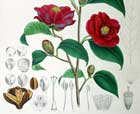 Camellia species - Evergreen shrubs from China and Japan. This group includes the well-known garden Camellias. They are quite hardy but dislike cold winds and alkaline soils, probably growing best in thin woodland. They are sometimes cultivated as an oil crop in the Orient, this oil is non-drying and is especially popular as a hair dressing. Species to try are japonica (the garden Camellia), C. olifera and C. sasanqua.
Camellia species - Evergreen shrubs from China and Japan. This group includes the well-known garden Camellias. They are quite hardy but dislike cold winds and alkaline soils, probably growing best in thin woodland. They are sometimes cultivated as an oil crop in the Orient, this oil is non-drying and is especially popular as a hair dressing. Species to try are japonica (the garden Camellia), C. olifera and C. sasanqua.
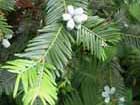 Cephalotaxus harringtonia - Is an evergreen coniferous shrub from the woodlands of Japan. It grows in most soils, succeeds in heavy shade but prefers light shade and dislikes exposed positions. Plants are either male or female but have been known to change sex. Obviously both sexes should be grown if seed is wanted (one male for every five females) although there are reports of isolated females producing fruits with infertile seed. Both seed and fruit are edible but can taste resinous.
Cephalotaxus harringtonia - Is an evergreen coniferous shrub from the woodlands of Japan. It grows in most soils, succeeds in heavy shade but prefers light shade and dislikes exposed positions. Plants are either male or female but have been known to change sex. Obviously both sexes should be grown if seed is wanted (one male for every five females) although there are reports of isolated females producing fruits with infertile seed. Both seed and fruit are edible but can taste resinous.
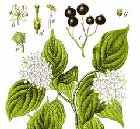 Cornus sanguinea - The Dogwood, is a native deciduous shrub found wild in mixed woods, scrub and hedgerows on calcareous soils, though it succeeds on most soils. It can also be grown as a hedge. The oil, which is non- drying, is obtained from both the seed and pericarp (the fleshy shell surrounding the seed). It is said to be edible when refined. Young branches of
Cornus sanguinea - The Dogwood, is a native deciduous shrub found wild in mixed woods, scrub and hedgerows on calcareous soils, though it succeeds on most soils. It can also be grown as a hedge. The oil, which is non- drying, is obtained from both the seed and pericarp (the fleshy shell surrounding the seed). It is said to be edible when refined. Young branches of
the plant are used in basket making and a grey-blue dye is obtained from the fruit.
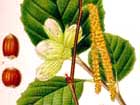 Corylus avellana - The British native Hazel, is a deciduous shrub of woods and hedgerows found especially on calcareous soils but succeeding on most soils. The oil is non-drying. As well as its seed, Hazel was once widely grown in coppices to provide wood for making hurdles, wattles, fences, etc. It might also be worthwhile trying other members of this genus such as C. colurna, and C. sieboldiana mandschurica (synonym C. mandschurica).
Corylus avellana - The British native Hazel, is a deciduous shrub of woods and hedgerows found especially on calcareous soils but succeeding on most soils. The oil is non-drying. As well as its seed, Hazel was once widely grown in coppices to provide wood for making hurdles, wattles, fences, etc. It might also be worthwhile trying other members of this genus such as C. colurna, and C. sieboldiana mandschurica (synonym C. mandschurica).
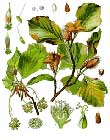 Fagus sylvatica - The British native Beech tree grows on most soils but avoids heavy, wet ones, it is abundant on chalk. Heavy crops are not produced every year. The oil is semi-drying and is said to store for a long time without growing rancid. The seed is also edible as are the young leaves that are produced in the two flushes of growth in spring and mid-summer.
Fagus sylvatica - The British native Beech tree grows on most soils but avoids heavy, wet ones, it is abundant on chalk. Heavy crops are not produced every year. The oil is semi-drying and is said to store for a long time without growing rancid. The seed is also edible as are the young leaves that are produced in the two flushes of growth in spring and mid-summer.
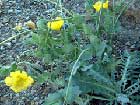 Glaucium flavum - The Horned Poppy is another British native species found on shingle banks of the coast. It is easily grown in any good garden soil but is, unfortunately, a fairly short-lived perennial. The oil is said to burn very cleanly in lamps.
Glaucium flavum - The Horned Poppy is another British native species found on shingle banks of the coast. It is easily grown in any good garden soil but is, unfortunately, a fairly short-lived perennial. The oil is said to burn very cleanly in lamps.
.jpg) Juglans regia - The Walnut tree, is more or less naturalised in southern England. It succeeds on most soils, preferring a deep loam, and strongly disliking windy positions. The oil is drying and quickly goes rancid. The seed is, of course, edible and amongst its other uses, the crushed leaves can be used as an insect repellent. Other Juglans species also have oil rich seeds although they may not be produced freely in temperate regions. It might be worthwhile trying J. cinerea, J .mandschurica or J nigra.
Juglans regia - The Walnut tree, is more or less naturalised in southern England. It succeeds on most soils, preferring a deep loam, and strongly disliking windy positions. The oil is drying and quickly goes rancid. The seed is, of course, edible and amongst its other uses, the crushed leaves can be used as an insect repellent. Other Juglans species also have oil rich seeds although they may not be produced freely in temperate regions. It might be worthwhile trying J. cinerea, J .mandschurica or J nigra.

Prunus species - This genus includes the Plum, Cherry, Almond, Apricot and Peach. The seed of all members of this genus could probably by used for oil extraction, although in our climate the Plum is probably the most reliable choice. The oil is semi-drying. One word of warning though, if the extracted oil should taste strongly of bitter almonds then it should only be consumed in small quantities.
 Rhus verniciflua (Toxicodendron vernicifluum) - The Japanese Lacquer tree is a deciduous tree from the woodlands of China and Japan. It succeeds in ordinary garden soil but is susceptible to Coral Spot fungus. The oil is drying. Indeed it is actually solid at room temperature and so can be used as a vegetable tallow in making candles. All parts of this tree including the oil are poisonous. A natural varnish or lacquer can be obtained from the sap of the tree.
Rhus verniciflua (Toxicodendron vernicifluum) - The Japanese Lacquer tree is a deciduous tree from the woodlands of China and Japan. It succeeds in ordinary garden soil but is susceptible to Coral Spot fungus. The oil is drying. Indeed it is actually solid at room temperature and so can be used as a vegetable tallow in making candles. All parts of this tree including the oil are poisonous. A natural varnish or lacquer can be obtained from the sap of the tree.
 Vitis vinifera - This is the Grape. Due to the size of the seed it would not normally be practicable to cultivate for oil production but if you grow a reasonable quality of grapes for wine or have access to someone else’s pulp from winemaking, then you could have a go. The oil is edible when refined and is also used in lighting.
Vitis vinifera - This is the Grape. Due to the size of the seed it would not normally be practicable to cultivate for oil production but if you grow a reasonable quality of grapes for wine or have access to someone else’s pulp from winemaking, then you could have a go. The oil is edible when refined and is also used in lighting.
Finally, a few words on extracting the oil. The best method to use if the oil is to be eaten is to squeeze out the oil in a press. As far as we know, there are no sources of domestic size oil presses in Britain, perhaps a fruit press could be adapted. Prior to crushing, it will improve extraction rates if you grind up the seed somewhat. This method of extraction will not get all the oil out however. If you then boil up the pulp, a lot more oil will then float to the surface of the water and be skimmed off. This oil is not so wholesome to use as a food but is perfectly alright for all its other applications. The oil should be stored in airtight containers.
Database
The database has more details on these plants: Althaea officinalis, Camellia sasanqua, Cephalotaxus harringtonia, Cornus sanguinea, Corylus avellana, Corylus colurna, Corylus sieboldiana, Corylus sieboldiana mandschurica, Fagus sylvatica, Glaucium flavum, Juglans cinerea, Juglans regia, Toxicodendron vernicifluum, Vitis vinifera.